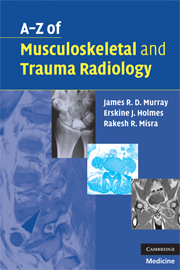Book contents
- Frontmatter
- Contents
- Acknowledgements
- Preface
- List of abbreviations
- Section I Musculoskeletal radiology
- Section II Trauma radiology
- ATLS – Advanced Trauma Life Support
- Acetabular fractures
- Aortic rupture
- Cervical spine injury
- Flail chest
- Haemothorax
- Open fractures
- Pelvic fracture
- Peri-physeal injury
- Pneumothorax
- Rib/sternal fracture
- Skull fracture
- Thoraco-lumbar spine fractures
- Acromioclavicular joint injury
- Carpal dislocation and instability
- Clavicular fractures
- Elbow injuries and distal humeral fractures
- Hand injuries – general principles
- Hand injuries – specific examples
- Thumb metacarpal fractures
- Humerus fracture – proximal fractures
- Humerus fracture – shaft fractures
- Humerus fracture – supracondylar fractures – paediatric
- Radius fracture – head of radius fractures
- Radius fracture – shaft fractures
- Galeazzi fracture dislocation
- Radius fracture – distal radial fractures
- Related wrist fractures
- Scaphoid fracture
- Scapular fracture
- Shoulder dislocation
- Ulna fracture – proximal and olecranon fractures
- Ulna fracture – shaft fractures
- Monteggia fracture dislocation
- Accessory ossicles of the foot
- Ankle fractures
- Bone bruising
- Calcaneal (Os calcis) fractures
- Femoral neck fracture
- Femoral shaft fracture
- Femoral supracondylar fracture
- Hip dislocation – traumatic
- Knee soft-tissue injury
- Metatarsal fractures – commonly fifth MT base
- Patella fracture
- Tibial-plateau fracture
- Tibial-shaft fractures
- Tibial-plafond (Pilon) fractures
- Talus fractures/dislocations
Thumb metacarpal fractures
from Section II - Trauma radiology
Published online by Cambridge University Press: 22 August 2009
- Frontmatter
- Contents
- Acknowledgements
- Preface
- List of abbreviations
- Section I Musculoskeletal radiology
- Section II Trauma radiology
- ATLS – Advanced Trauma Life Support
- Acetabular fractures
- Aortic rupture
- Cervical spine injury
- Flail chest
- Haemothorax
- Open fractures
- Pelvic fracture
- Peri-physeal injury
- Pneumothorax
- Rib/sternal fracture
- Skull fracture
- Thoraco-lumbar spine fractures
- Acromioclavicular joint injury
- Carpal dislocation and instability
- Clavicular fractures
- Elbow injuries and distal humeral fractures
- Hand injuries – general principles
- Hand injuries – specific examples
- Thumb metacarpal fractures
- Humerus fracture – proximal fractures
- Humerus fracture – shaft fractures
- Humerus fracture – supracondylar fractures – paediatric
- Radius fracture – head of radius fractures
- Radius fracture – shaft fractures
- Galeazzi fracture dislocation
- Radius fracture – distal radial fractures
- Related wrist fractures
- Scaphoid fracture
- Scapular fracture
- Shoulder dislocation
- Ulna fracture – proximal and olecranon fractures
- Ulna fracture – shaft fractures
- Monteggia fracture dislocation
- Accessory ossicles of the foot
- Ankle fractures
- Bone bruising
- Calcaneal (Os calcis) fractures
- Femoral neck fracture
- Femoral shaft fracture
- Femoral supracondylar fracture
- Hip dislocation – traumatic
- Knee soft-tissue injury
- Metatarsal fractures – commonly fifth MT base
- Patella fracture
- Tibial-plateau fracture
- Tibial-shaft fractures
- Tibial-plafond (Pilon) fractures
- Talus fractures/dislocations
Summary
Characteristics
Most fractures involve the base of thumb and are classified as intra or extra articular fractures.
Intra-articular injury is important as malunion preferentially impairs the important functions of key grip and opposition.
The common types of intra-articular fracture have been described by Bennett and Rolando.
Common secondary to forced abduction of the thumb.
Clinical features
Pain, swelling and thenar bruising often evident.
Thumb deformity/malalignment and reduced range of movement.
Radiological features
AP and lateral views essential – oblique view may be beneficial.
Bennett's fracture – a distinctive small ulnar-sided fragment is seen to maintain its alignment with the trapezium. The thumb metacarpal is dislocated dorsally and radially due to the action of abductor pollicis longus.
Rolando fracture – a fracture of the base of thumb extending into the carpo-metacarpal joint. The fracture line has a V or a T configuration.
Extra-articular fractures are basal (transverse or oblique fractures just distal to the CMC joint) or pure shaft injuries.
Management
Assess soft tissues, neurovascular status and immobilise initially.
Bennett's fracture – Reduce with traction while abducting the thumb and applying pressure to the radial aspect of the base. K-wiring will usually suffice, but occasionally ORIF with large ulnar-sided fragments.
Maintain position in a thumb spica and watch carefully in the hand/fracture clinic with weekly radiographs.
Rolando fracture – Reduce and immobilise if undisplaced. ORIF for displaced fractures to restore CMC joint congruity.
Extra-articular fractures – usually managed non-operatively as the thumb can tolerate 20° to 30° of angulation without functional impairment, because of adjacent joint mobility.
- Type
- Chapter
- Information
- A-Z of Musculoskeletal and Trauma Radiology , pp. 248 - 250Publisher: Cambridge University PressPrint publication year: 2008



